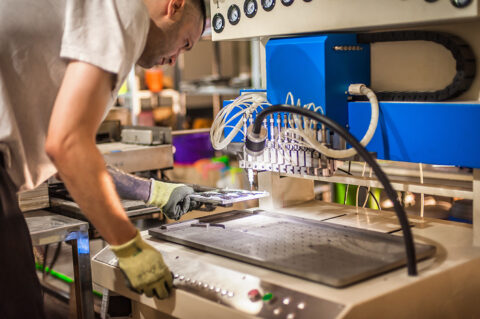Opening — Manufacturing Shows Strain, Strategy Takes Shape
The October data from the Institute for Supply Management landed like a cold front across America’s factory floor. The manufacturing PMI slipped to 48.7, the eighth straight month in contraction territory. New orders are soft, hiring is cooling, and supply managers continue to cite tariff uncertainty and high input costs as daily headwinds.
And yet, underneath the surface slowdown, America’s industrial base keeps repositioning for the long game. While some shop floors are feeling the pinch, others are building the foundations of a more resilient future—from CHIPS-funded critical-materials plants to next-generation semiconductor projects. The week’s headlines tell a story not of decline, but of deliberate transformation.
1️⃣ Manufacturing Contraction Deepens
The ISM’s October reading confirms what many small manufacturers already know: conditions remain tight. Output and new-order indexes both slipped, reflecting a cautious customer environment shaped by tariffs and cost inflation.
Why it matters: This is less a recession signal than a recalibration. U.S. manufacturing is working through structural change—re-locating supply chains, re-training workforces, and re-investing in domestic capacity. Periods like this test resilience but also reveal where the next wave of growth will emerge.
(Source: Reuters, Nov 3 2025)
2️⃣ Commerce and Vulcan Elements Forge CHIPS Deal for Rare-Earth Magnets
In a sign of how industrial policy is maturing, the Department of Commerce signed a CHIPS incentives letter of intent with Vulcan Elements to build out domestic rare-earth magnet production. These magnets are essential for everything from jet fighters to EV motors.
Why it matters: By targeting upstream vulnerabilities, Washington is expanding the CHIPS strategy beyond semiconductors to the deep supply chain where national security begins. This is the kind of capacity-building that levels the playing field for American manufacturers and reduces dependency on Chinese sources.
(Sources: NIST / U.S. Dept. of Commerce; Reuters, Nov 3 2025)
3️⃣ USTR Recalibrates Tariff Pressure on China
The U.S. Trade Representative opened a public comment docket on suspending some Section 301 tariffs tied to China’s maritime and logistics sectors.
Why it matters: The move signals a more surgical approach—maintaining leverage where it protects strategic technologies while easing costs where domestic alternatives remain limited. For small and midsized manufacturers balancing thin margins, this kind of precision policy can make a real difference.
(Sources: USTR; KPMG Tax & Legal, Nov 6 2025)
4️⃣ Micron’s New York Megafab Pushes to 2026
Micron’s long-anticipated memory-chip facility in central New York cleared its environmental review, but construction now won’t start until spring 2026, with completion targeted for 2030.
Why it matters: Big industrial projects move on decade timelines. The delay underscores how permitting, infrastructure, and skilled-labor readiness remain gating factors in America’s manufacturing renaissance.
(Source: Local news, Nov 7 2025)
Quick Hits — Around the Horn
-
Semiconductor Boom: Global chip sales hit $208.4 B in Q3 2025, up 25 % YoY, confirming that long-term demand for advanced electronics is still climbing. (SIA, Nov 3 2025)
-
Tariff Pressure Persists: ISM respondents continue to flag trade friction as a top constraint on investment and hiring. (Reuters, Nov 3 2025)
-
Policy Pipeline Expands: Commerce released new CHIPS R&D funding calls focused on supply-chain innovation. (Inside Government Contracts, Nov 5 2025)
Closing — Short-Term Slowdown, Long-Term Rebuild
It’s easy to read a sub-50 PMI and assume decline. But that misses the bigger mission. The U.S. is in the first innings of a 20- to 30-year restructuring—from fragile global dependency toward distributed domestic strength. The week’s stories show the friction and the forward motion side by side: soft orders today, strategic investment for decades ahead.
Manufacturing remains a team sport done in community. Each new project, each policy refinement, and each small shop adapting to new realities adds another link to the chain of American industrial resilience.
Next up: Watch factory-order data, CHIPS grant announcements, and responses to USTR’s tariff review. The direction is clear—even through turbulence, the U.S. manufacturing network is learning to build together again.




